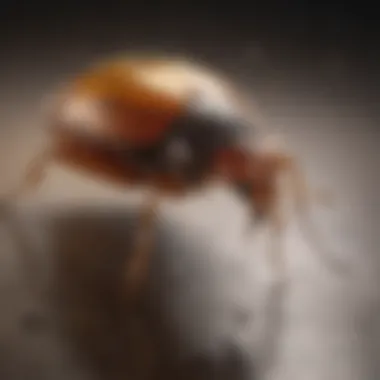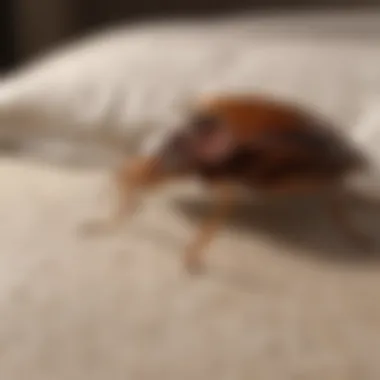Natural Solutions for Effective Bed Bug Control


Intro
Bed bugs have become a significant concern for many home owners and housewives as these pests can create discomfort and distress within one's living space. They are small, flat, brown insects that feed on the blood of humans and animals. Understanding how to effectively identify, prevent, and treat bed bug infestations using natural methods is crucial. This article aims to equip readers with comprehensive strategies, combining practical methods with a focus on health and environmental impacts. By exploring these methods, homeowners can maintain a safe and pest-free environment.
Pest Identification
Detailed Descriptions of Common Pests
Bed bugs, scientifically known as Cimex lectularius, are the most common pests associated with residential infestations. Adults are approximately the size of an apple seed, with a reddish-brown color and a visible flattened body. They can easily hide in tiny crevices during the day, coming out only at night in search of a meal. Infants, or nymphs, are smaller, almost transparent, and very hard to spot in the early stages of an infestation.
Signs and Symptoms of Infestations
Identifying a bed bug infestation can be challenging. However, several signs can provide important clues:
- Bites: Bed bug bites appear as small, red welts and may cause itching.
- Blood Stains: Small blood spots on sheets or pillowcases can indicate bed bugs have been feeding.
- Fecal Spots: Dark, small spots may be visible on surfaces near where they hide.
- Shed Skins: As bedbugs grow, they shed their skins, which can often be found in their hiding places.
Awareness of these signs is essential for quick action before infestations worsen.
Prevention Strategies
Home Maintenance Tips for Pest Prevention
Maintaining a clean living environment can significantly reduce the risk of bed bug infestations. Consider the following tips:
- Regular Vacuuming: Vacuum floors, carpets, and upholstery thoroughly and frequently.
- Decluttering: Reducing clutter makes it more difficult for bed bugs to find hiding spots.
- Wash Bedding Regularly: Hot washing bed linens and pillowcases can eliminate bed bugs and their eggs.
- Seal Cracks and Joints: Inspect and seal any crevices in walls and furniture to minimize hiding places.
Natural Deterrents and Barriers
Utilizing natural deterrents can create an inhospitable environment for these pests:
- Diatomaceous Earth: This powdery substance is made from fossilized algae and can deter bed bugs when sprinkled in infested areas.
- Essential Oils: Oils like lavender, tea tree, and peppermint can repel bed bugs due to their strong scents.
- Baking Soda: This common household item can dehydrate bed bugs upon contact, reducing their population.
Implementing these practices can assist in keeping your home free from infestations.
Treatment Options
Overview of Chemical vs. Natural Treatments
When facing bed bug infestations, many homeowners must choose between traditional chemical treatments and natural remedies. Chemical treatments often involve pesticides that can be harmful to both health and environment. In contrast, natural methods focus on safety and sustainability, making them more appealing for many.
Step-by-Step Guides for DIY Treatments
For those inclined to embark on DIY treatments, several natural methods can help eliminate bed bugs effectively:
- Steam Cleaning: Use a steam cleaner on infested areas to kill adult bed bugs and their eggs instantly.
- Vacuuming and Disposal: After vacuuming, ensure you immediately seal and dispose of the vacuum bag outdoors to prevent reinfestation.
- Combination Treatments: Create a homemade spray using a mix of water and essential oils to treat affected areas. Spray on surfaces noted for signs of bed bugs and allow it to dry.
Choose your approach wisely, and always consider both effectiveness and the potential impact on health.
It is critical to regularly inspect your home for signs of bed bugs, especially after traveling or hosting guests. Prompt identification can save you from complete infestations.
By using natural methods for bed bug elimination, homeowners can foster a safe, healthy environment for their families.
Understanding Bed Bugs
Understanding bed bugs is crucial for anyone dealing with these pests. Knowledge of their biology, behavior, and impact on health sets the foundation for effective elimination strategies. The first step in addressing any infestation is recognizing the nature of the pest involved.
Biology and Behavior of Bed Bugs
Bed bugs are small, flat, reddish-brown insects that feed on the blood of humans and animals. Their size ranges from a quarter inch to a half inch, making them easily overlooked. Understanding their life cycle is essential; they undergo five nymphal stages before reaching maturity, which can take as little as a few weeks under favorable conditions. An adult female can lay hundreds of eggs, making rapid population growth possible.
Bed bugs are predominantly nocturnal, preferring to hide during the day in cracks and crevices. They often take shelter in mattresses, furniture, and even electronics. Their ability to go without a meal for several months makes them particularly resilient and difficult to eradicate.


Signs of Infestation
Recognizing the signs of bed bug infestation is the first step towards resolution. Look for the following indicators:
- Bites on the Skin: Bed bug bites often appear as small, itchy welts, typically in a line or cluster.
- Dark Spots: These are fecal stains left by bed bugs after feeding.
- Eggshells and Molts: The shed skins and eggs of bed bugs may be found in their hiding places.
- Unpleasant Odor: A sweet yet musty smell can be a sign of a substantial infestation.
Missing these signs can lead to a larger infestation, as bed bugs multiply rapidly.
Impact of Bed Bugs on Health
The impact of bed bugs extends beyond mere discomfort. Bed bug bites are not known to transmit diseases, but they can lead to skin infections caused by scratching the welts. Moreover, infestations can cause significant psychological distress. Many experience anxiety and sleep disturbances due to the fear of being bitten. This impact on mental health can be particularly significant for individuals already dealing with anxiety or other conditions.
Natural Remedies for Bed Bug Control
Natural remedies for bed bug control hold significant importance for homeowners seeking effective solutions without resorting to harsh chemicals. These remedies not only target the bed bug problem but do so with a focus on safety and environmental sustainability. The use of natural methods offers a dual benefit: effectively combatting these pests while minimizing potential health risks to humans and pets. In this section, we delve into specific natural methods, their advantages, and considerations necessary to implement them successfully.
Diatomaceous Earth
Diatomaceous Earth is a staple in natural pest control. Composed of fossilized remains of tiny aquatic organisms, it works as an abrasive material that damages the exoskeleton of bed bugs. This results in dehydration and ultimately death. The application of Diatomaceous Earth is straightforward; it can be dusted in areas where bed bugs are likely to hide, such as around bed frames and in cracks and crevices.
A key characteristic of Diatomaceous Earth is its non-toxic nature, making it a safe choice for households with children and pets. However, it's essential to use food-grade types for safety. The main disadvantage is that it may take a while to start seeing results, as the bed bugs must come into contact with the powder for it to be effective.
Essential Oils
Lavender Oil
Lavender Oil is well-known for its pleasing aroma and calming effects. Beyond its pleasant scent, it has properties that can repel bed bugs. The key characteristic of Lavender Oil is its ability to disrupt the bed bugs' nervous system. This unique feature makes it a popular choice among natural remedies. While effective in repelling these pests, it may not kill them outright. Regular application is necessary to maintain effectiveness.
Tea Tree Oil
Tea Tree Oil holds a strong reputation for its antiseptic and repellent properties. This oil can effectively kill bed bugs on contact, making it beneficial for immediate treatment needs. The unique feature of Tea Tree Oil is its ability to penetrate the exoskeleton of insects, targeting them directly. A drawback, however, is its strong scent, which some may find overpowering. Proper ventilation is encouraged during its use.
Peppermint Oil
Peppermint Oil provides a strong scent that many find refreshing. Within the context of pest control, it serves as a deterrent to bed bugs. Its key characteristic is the menthol component, which is known to repel insects. However, as with Lavender Oil, it may not possess the potency to eliminate bed bugs entirely. Frequent reapplication is necessary for effective control.
Heat Treatment
Heat Treatment is a powerful method for eradicating bed bugs. This process involves exposing infested items to high temperatures, effectively killing bed bugs and their eggs. The effectiveness of this method lies in its ability to reach temperatures above 120°F (49°C), which is lethal for pests. Hot Water Washing and Steam Cleaning are both integral aspects of this method.
Hot Water Washing
One effective heat treatment method is Hot Water Washing. This involves washing bed linens, clothing, and any other potentially infested items in hot water. The key characteristic of this method is the ease with which it can be implemented; many households already have the necessary equipment. The advantage it offers is chemical-free pest elimination. However, colorfastness of items should be considered to avoid damaging fabrics.
Steam Cleaning
Steam Cleaning is another effective heat treatment used against bed bugs. Utilizing steam at high temperatures not only kills bed bugs but also penetrates into soft materials where they might hide. A significant advantage of steam cleaning is that it sanitizes the surface treated, leaving a generally cleaner environment. The drawback is that specialized equipment may be required, and care must be taken to reach all infested areas.
Natural Insecticidal Soaps
Natural insecticidal soaps offer another option for bed bug control. These soaps work effectively by suffocating the pests. The primary advantage of such soaps is their primarily plant-derived ingredients, which make them safe for use around children and pets. However, its effectiveness may be limited if the bed bugs are hidden away, as the soap must come into contact with the pests to work. Regular applications may also be necessary to maintain effectiveness.
Practical Application of Natural Methods
Preparation Before Treatment
Preparation is key before embarking on the treatment of bed bugs. It ensures that your living space is ready for the application of remedies. This stage includes decluttering and laundering bedding, which play vital roles in enhancing the effectiveness of natural methods.
Decluttering
Decluttering is a significant step in pest control. Removing unnecessary items from your space can expose bed bugs and their hiding spots. This process simplifies treatment by allowing direct access to affected areas. It is a beneficial choice because it also enhances the overall cleanliness of the home. However, moving items around without proper organization can inadvertently spread bugs to new areas.


Laundering Bedding
Laundering bedding is another essential preparation. Washing sheets, pillowcases, and blankets in hot water helps kill bed bugs and their eggs. This method is widely recognized for its effectiveness, especially since bed bugs often reside in or near sleeping areas. The unique aspect of laundering is that it is an accessible treatment method that only requires a washing machine and dryer. However, it is not a standalone solution, as it must be combined with other techniques for comprehensive control.
Applying Diatomaceous Earth
Diatomaceous earth is a natural powder made from fossilized algae. It can be sprinkled in areas where bed bugs are suspected. This method works by damaging the exoskeleton of the insects, leading to dehydration. The key characteristic of diatomaceous earth is its physical action rather than chemical, which makes it a safe alternative in homes with children or pets. Its unique feature is that it can last for a long time if not disturbed. However, it requires careful application to ensure even distribution.
Utilizing Essential Oils
Essential oils like lavender, tea tree, and peppermint can deter bed bugs effectively.
Dilution and Application Techniques
Dilution and application techniques are crucial when using essential oils. This involves mixing essential oils with a carrier oil or water before application, ensuring that the oils are safe for direct use. This choice is beneficial because it allows for a wider range of usage without overwhelming the skin or surfaces. The unique feature of proper dilution is that it maximizes effectiveness while minimizing risk of irritation. However, incorrect ratios can lead to either ineffective treatment or potential adverse reactions.
Area Coverage
Area coverage is vital when using essential oils for pest control. Ensuring that all infested areas are treated evenly enhances the chances of eliminating the bed bug population. A strategic approach, includes spraying in seams of mattresses, cracks in furniture, and baseboards. This method is popular as it uses ubiquitous and pleasant-smelling oils. Its unique feature is that it integrates a natural approach to pest control like prevention of future infestations. However, it requires diligence to maintain coverage, as thoroughness is imperative for effectiveness.
Implementing Heat Treatment
Heat treatment is an effective way to eliminate bed bugs by exposing them to high temperatures.
Temperature Guidelines
Temperature guidelines suggest maintaining a temperature of at least 120°F (49°C) for effective treatment. This is essential for ensuring that bed bugs and their eggs are killed. The benefit of heat treatment is that it penetrates into the fabric and can reach bugs hiding in cracks. The unique feature is that it often requires specific equipment like heaters or steamers, which could be an investment.
Monitoring Duration
Monitoring duration during heat treatment is also important. Keeping items at the required temperature for a specific timeframe ensures thorough extermination. The distinctive quality of this method is that it provides immediate results, unlike some chemical methods which require several applications. However, care must be taken to avoid damage to delicate items during the process.
Using Insecticidal Soaps
Insecticidal soaps are a natural option that can specifically target bed bugs.
Application Techniques
Application techniques for insecticidal soaps dictate how effectively the remedy works. Spraying directly onto the insects ensures contact and dissolution of their protective outer layer. This detailed approach enhances targeting and effectiveness. The method is popular because it is easy to use and relatively low in toxicity. However, coverage can be difficult if infestations are widespread, as the soap must directly contact bugs to work effectively.
Frequency of Use
The frequency of use regarding insecticidal soaps is critical. Regular application is often necessary to break the lifecycle of the bed bugs. This allows for new cohorts of bugs that hatch from eggs to be targeted before they can reproduce. Its unique aspect is that it must be combined with other methods for sustained control. While this method has advantages, including ease of use, the need for continual application can be seen as a disadvantage.
Preventive Measures
Preventive measures are key to avoiding a bed bug infestation. These pests can be elusive and resilient, making it essential to implement strategies that minimize their chances of entering your home. Focusing on prevention is advantageous because it can save time, money, and stress associated with dealing with an infestation after it has occurred. In this section, we will explore various preventive techniques that households can adopt.
Routine Inspections
Regular inspections are crucial. By checking your home for signs of bed bugs, you can catch a potential infestation early. Focus on areas where bed bugs commonly reside, such as bedrooms, including under the mattress, inside seams, and bed frames.
Look for the following signs:
- Live bed bugs or shed skins
- Fecal spots, which are dark specks left behind
- Bite marks on your skin in the morning
Develop a habit of inspecting your home at least once a month, particularly after guests visit or if you return from travel. Early detection is vital for effective management.
Vacuuming Techniques
Vacuuming is not just about cleaning. It is a proactive measure to reduce the risk of bed bugs. Use a vacuum with a strong suction to reach cracks and crevices in furniture and carpets.


Key points to keep in mind:
- Use a HEPA filter: This can trap small particles, including adult bed bugs and eggs.
- Dispose of vacuum contents properly: Seal the bag or container to prevent bugs from escaping and spreading.
- Vacuum crucial areas: Pay special attention to beds, couches, and areas near where pets sleep.
Frequent vacuuming can significantly lower the number of bed bugs and lessen the risk of an infestation.
Sealing Cracks and Crevices
Sealing cracks and crevices is another effective preventive strategy. Bed bugs find their way into homes through tiny openings. By sealing these spaces, you reduce the likelihood of their entry.
Consider the following actions:
- Fill gaps in walls and baseboards: Use caulk or a similar filler for gaps.
- Seal furniture: Ensure that furniture is in good repair, with no loose joints that can harbor bed bugs.
- Inspect areas around pipes and electrical outlets: These can be common entry points if not sealed properly.
Investing time in sealing potential entry points can yield significant dividends by keeping bed bugs out.
Travel Precautions
Traveling can introduce bed bugs into your home. Being mindful while traveling is essential to preventing infestations. Here are some thoughtful travel precautions:
- Inspect hotel rooms: Examine the bed, headboard, and surrounding areas for signs of bed bugs before unpacking.
- Keep luggage elevated: Use luggage racks to keep your bags off the floor and bed.
- Launder clothes promptly: Wash clothes immediately after returning home.
By maintaining awareness during travels, you can keep your home bed bug-free.
"Prevention is better than cure"—Implementing these preventive measures can save countless hours of dealing with infestations in the future.
Environmental and Health Considerations
The role of environmental and health considerations in pest control cannot be overstated. As households grapple with bed bug infestations, the choice of elimination strategies has profound implications. Both the effectiveness of these methods and their overall impact on the environment and human health must be evaluated carefully.
When dealing with pests, it is crucial to employ methods that do not compromise the safety of household members or pets. Many commercial insecticides contain harsh chemicals that can pose risks. Thus, using natural remedies is appealing, as they tend to minimize adverse effects. They are a more sustainable approach to pest management, aligning closely with a growing emphasis on eco-conscious living.
Effectiveness of Natural Remedies
Natural remedies for bed bug control can be surprisingly effective if applied correctly. The reliance on non-toxic solutions ensures that homes remain safe for occupants. Methods such as diatomaceous earth and essential oils have shown efficacy in disrupting bed bug life cycles, impacting their ability to reproduce and thrive. In practical settings, these remedies might not eliminate bugs in one application. Instead, they require a strategic approach involving consistent use and proper application techniques.
Moreover, the effectiveness of these methods can vary based on infestation levels and individual circumstances. The subtlety of using approaches that perhaps lack the immediate results of chemical treatments does not diminish their potential for long-term success. Recognizing these factors is essential for households eager to find balance between effectiveness and safety.
Safety of Ingredients
The safety of ingredients used in natural pest control warrants particular attention. With the rise of natural living, many consumers look for options that assure them of reduced health risks. Ingredients such as essential oils, including lavender oil or tea tree oil, are considered safe when used properly. They have been known for their insect-repelling properties, contributing to both efficacy and safety.
However, it is important for individuals, especially those with allergies or sensitivities, to check for adverse reactions. Ensuring that the chosen natural ingredients do not pose health risks is crucial. Organic certifications might also provide a layer of reassurance for individuals making health-conscious choices.
Sustainable Practices in Pest Control
Sustainable practices in pest control promote ongoing health for the environment while addressing infestation concerns. Emphasizing methods that rely on natural ingredients aligns with ecological conservation goals. Households can inadvertently contribute positively to the environment by avoiding the extensive use of synthetic chemicals.
In addition, these practices encourage comprehensive strategies that go beyond immediate eradication. By implementing continuous maintenance habits such as regular inspections and cleansing routines, homeowners can contribute to better pest control systems. This long-term view fosters not just an insect-free dwelling but also a more balanced relationship with the surrounding ecosystem.
Epilogue
The conclusion is a vital segment of this article as it encapsulates the essence of managing bed bug infestations through natural methods. Understanding effective strategies is crucial for homeowners and housewives who seek to maintain a safe and pest-free home environment.
Summary of Natural Approaches
Several natural methods have been highlighted throughout this article. These approaches include using Diatomaceous Earth, various essential oils, heat treatments, and natural insecticidal soaps. Each of these methods is grounded in both effectiveness and safety, offering alternatives to chemical pesticides that can harm the environment and the health of residents. Awareness of these options empowers individuals to act quickly and wisely in the face of an infestation.
For instance, using Diatomaceous Earth involves spreading this natural substance in infested areas, resulting in the desiccation of bed bugs. Essential oils like lavender, tea tree, and peppermint can be used for their repellent properties, while heat treatments can eliminate pests through temperature elevation. Insecticidal soaps offer a way to safely target bed bugs in a manner that is less harmful than traditional products.
Future Considerations in Bed Bug Management
As we consider future actions in bed bug management, it is essential to acknowledge the need for ongoing vigilance. Regular inspections and the adaptation of preventive techniques will be critical in minimizing the likelihood of re-infestation. Furthermore, research is continuously evolving in the area of pest control, with new and innovative methods being explored.
- Integrating technology: New tech solutions like monitoring devices designed for pest detection may emerge, providing early alerts to homeowners.
- Sustainability: As eco-consciousness rises, consumers may demand more naturally derived solutions, pushing manufacturers to adopt cleaner production methods.
- Education: Proliferating information about sustainable and natural remedies will help raise public awareness.
Monitoring these trends will be key for stayin vigilant against bed bugs. Effective bed bug management is a multifaceted approach that includes applying known methods and remaining receptive to new developments in natural pest control.



